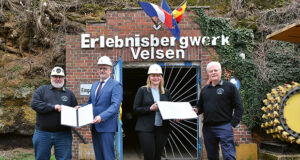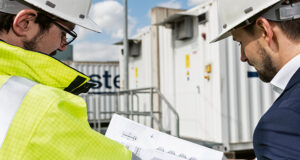Mining leaves its mark – water in particular as a resource in the former mining regions is affected by the consequences of intensive raw material extraction, some of which has been ongoing for centuries. The key issues in this year’s “NACHBergbauzeit in NRW” conference (Figure 1) looked at the challenges involving the long-term management of water and the resulting effects from the planned increase in pit water levels. The District Government of Arnsberg as the mining authority for North Rhine-Westphalia and the TH Georg Agricola University (THGA), Bochum/Germany, held the joint specialist conference for the sixth time on 10th March 2022. The 250 or so participants exchanged their professional views online on the subject of “Pit water – planned on paper, discussed online”.
In his welcoming address, Hans-Josef Vogel, District President of the District Government of Arnsberg, emphasised the vital cooperation of universities and public administration: “This innovation partnership guarantees the scientific basis for problem solving in the economy, in communities and in civil society. The research into post-mining is a very tangible example of how we can open up new vistas together, with a view to climate protection.”
Bärbel Bergerhoff-Wodopia, Member of the Board of Executives of the RAG-Stiftung, Essen/Germany, added: “In times of a recycling economy, but also with the increased use of georesources, among other things, for electric mobility, it is important to think about post-mining. For only with our post-mining experience can we succeed in using georesources sustainably today and in the future – this will only be the case if post-mining is considered right from the start in every mining process.” New ideas and innovations are needed to resolve the challenges of the future together and to unlock brand new potential.
The presentations of the conference primarily addressed the effects of the planned increase in pit water on the mining districts in North Rhine-Westphalia and in the Saarland. The speaker, Thomas Im-grund from DMT GmbH & Co. KG, explained the possible effects of rising water levels on pit gas extraction. He also estimated the overall possible impacts of the process on the emission of methane on the ground surface. He concluded with a positive outcome. With targeted extraction and utilisation of the pit gas, uncontrolled emissions would decrease considerably. The rising pit water would also cause flooding of flow paths and a lower gas output overall in the long term.
Manuela Nie and Mario Sommerhäuser from the Emschergenossenschaft/Lippeverband (EGLV), Essen/Germany, offered a very different view on the pit water. In their pre-sentation, they addressed the significance it currently has and will have on the flora, fauna and water quality in the Emscher-Lippe region. Overall, they acknowledged that the region demonstrated good ecological development. The impacts of pit water discharge are currently very low due to fast and heavy dilution in the river waters, which is perhaps why the salt concentration is well below the limit – and they continue to decrease. According to the EGLV’s plans, the whole Emscher will be completely free of pit water from September 2022.
The presentations in the second part of the event covered the challenges faced regarding the responsible handling of PCBs. This abbreviation stands for polychlorinated biphenyls; chemical chlorine compounds which were used in the coal mining industry, e. g., in hydraulic systems, transformers and gearboxes. The fact that PCBs are potentially harmful to human health and the environment was not known for some time. The use of this substance was not forbidden until the mid 1980s – traces can still be detected in pit water today, albeit in very low levels.
In his speech, Michael Denneborg presented a report commissioned by the North Rhine-Westphalian regional government to assess possible risks for ground waters and surface waters. In it, the qualified geologist from ahu GmbH, Aachen/Germany, looked at the possible effects of rising pit water on the discharge of PCB and other residual materials. His conclusion: Overall, higher pit water levels reduced the flow of PCB and the pit water volume in bodies of water over the long term.
Following this, Joachim Löchte from RAG Aktiengesellschaft, Essen/Germany, presented the intensive monitoring programmes developed by the company in order to constantly check and systematically record the flow of PCB into pit water. He covered the technical challenges faced during monitoring in particular. He also presented current projects the RAG is working on, with scientific support from the Research Center for Post-Mining (FZN) at the THGA, with the aim of further minimising contaminants, e. g., using special filters and treatment plants.
(Carmen Tomlik (THGA)/Si.)



